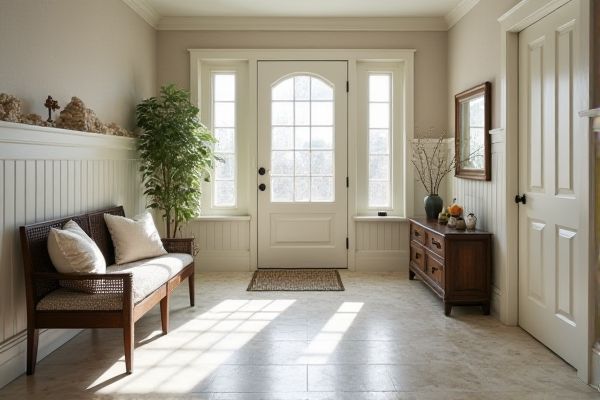
Mudroom wall tiles prioritize aesthetics and moisture resistance, while floor tiles focus on durability, slip resistance, and heavy foot traffic endurance to ensure safety and longevity. Explore the rest of this article to discover which tile best suits your mudroom's unique needs.
Table of Comparison
| Feature | Wall Tile | Floor Tile (Mudroom) |
|---|---|---|
| Material Durability | Less durable, designed for vertical surfaces | Highly durable, designed to withstand heavy foot traffic |
| Slip Resistance | Typically low slip resistance | High slip resistance for safety |
| Thickness | Thinner (usually 6-8 mm) | Thicker (usually 8-12 mm or more) |
| Installation Surface | Installed on walls | Installed on floors, suitable for uneven surfaces |
| Water Resistance | Moderate, suitable for splash areas | High, resistant to moisture and water exposure |
| Maintenance | Easy to clean, less prone to damage | Requires regular cleaning, designed to handle dirt and mud |
| Design & Texture | Wide range of decorative options | Focus on textured, slip-resistant finishes |
| Cost | Generally less expensive | Typically more costly due to durability |
Understanding Wall Tile vs Floor Tile
Wall tiles and floor tiles differ significantly in durability, thickness, and slip resistance, making floor tiles more robust to withstand heavy foot traffic and weight, especially in a mudroom. Mudrooms require floor tiles with high PEI ratings (typically PEI 3 or above) for abrasion resistance, while wall tiles often have lower PEI ratings and are thinner, designed primarily for aesthetic purposes. Selecting the appropriate tile type ensures safety, longevity, and functionality in high-moisture, high-traffic mudroom environments.
Key Differences Between Wall and Floor Tiles
Wall tiles and floor tiles differ significantly in durability, thickness, and slip resistance; floor tiles are thicker and designed to withstand heavier foot traffic and impact, while wall tiles are thinner and primarily aesthetic. Slip resistance is crucial for floor tiles, especially in a mudroom where moisture and dirt are common, whereas wall tiles prioritize design and ease of cleaning. Your choice should consider these factors to ensure functionality and safety in the mudroom environment.
Tile Durability: What Matters in a Mudroom
Wall tiles typically have lower durability and water resistance compared to floor tiles, making floor tiles the preferred choice for a mudroom where high traffic and moisture exposure are common. Mudroom floor tiles should feature high PEI ratings (Porcelain Enamel Institute) of at least PEI 3 to withstand heavy foot traffic and resist scratching, while wall tiles often have lower ratings and are less suited for such demands. Selecting floor tiles with strong slip resistance and stain-proof properties ensures your mudroom maintains both safety and aesthetics over time.
Slip Resistance and Safety Considerations
Wall tiles typically have a smoother finish designed for aesthetics, making them less slip-resistant compared to floor tiles, which are manufactured to withstand foot traffic and provide greater traction in spaces like mudrooms. Floor tiles for mudrooms often feature textured or matte surfaces to enhance slip resistance, reducing the risk of falls in wet or muddy conditions. Ensuring your mudroom floor uses tiles with high COF (Coefficient of Friction) ratings improves safety by minimizing slip hazards.
Thickness and Strength Comparison
Floor tiles for mudrooms generally feature greater thickness and enhanced strength compared to wall tiles, designed to withstand heavy foot traffic and potential impacts. Wall tiles are thinner and less durable as they primarily serve decorative purposes and do not bear weight. Selecting floor tiles ensures your mudroom floor remains resistant to cracks and wear, maintaining its functionality and appearance over time.
Design Options for Mudroom Tiles
Mudroom wall tiles offer a wide range of design options including ceramic, glass, and porcelain with decorative patterns that add texture and visual interest to vertical surfaces. Floor tiles in mudrooms prioritize durability and slip resistance, featuring materials like porcelain, natural stone, and textured ceramic designed to withstand heavy foot traffic and moisture. Combining contrasting colors or complementary materials between wall and floor tiles creates a cohesive and stylish mudroom aesthetic while ensuring functionality.
Installation Challenges: Wall vs Floor Tiles
Installing wall tiles in a mudroom typically involves addressing the challenge of securing tiles to vertical surfaces, requiring strong adhesives and precise leveling to prevent slippage. Floor tiles demand more robust installation techniques, including proper subfloor preparation, waterproofing, and grout application to withstand foot traffic and potential moisture. Understanding these differences helps you achieve a durable and visually appealing finish tailored to each surface's unique requirements.
Cost Factors: Wall Tile vs Floor Tile
Mudroom wall tiles generally cost less than floor tiles due to lower durability requirements and thinner materials, which reduce manufacturing expenses. Floor tiles must withstand heavier foot traffic and moisture exposure, leading to higher prices for stronger materials like porcelain or natural stone. Your budget allocation should consider installation complexity, as floor tiles often require additional labor and underlayment, increasing total costs compared to simpler wall tile installations.
Maintenance and Cleaning in Mudrooms
Wall tiles in mudrooms require less frequent cleaning compared to floor tiles, as they are less exposed to dirt and moisture. Floor tiles must withstand constant foot traffic, mud, and moisture, necessitating regular sweeping, mopping, and occasional deep cleaning to prevent grime buildup. Choosing non-porous, durable tiles for floors enhances ease of maintenance and longevity in high-traffic mudroom areas.
Choosing the Right Tile for Your Mudroom
Wall tiles typically feature a glazed surface designed for vertical applications, offering aesthetic appeal and easy cleaning, while floor tiles for mudrooms prioritize durability, slip resistance, and water absorption standards to withstand heavy foot traffic and moisture. Porcelain and ceramic floor tiles with PEI ratings of 3 or higher are ideal for mudrooms due to their hardness and low porosity, preventing damage from dirt and water exposure. Selecting tiles that meet the ANSI A137.1 standards for both slip resistance (COF >= 0.42) and water absorption (<= 0.5% for porcelain) ensures long-lasting performance and safety in mudroom environments.
 homyna.com
homyna.com